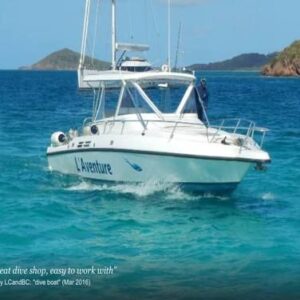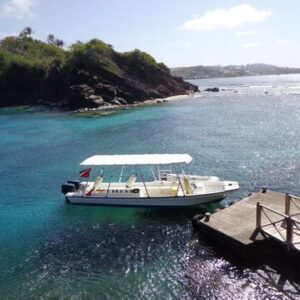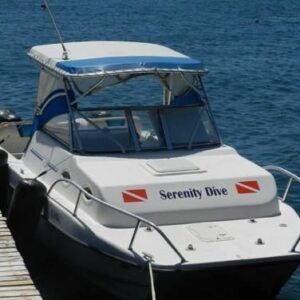The country of St. Vincent and the Grenadines is an archipelago in the Southern Caribbean comprised of the main island and the northern two-thirds of the Grenadines. The Grenadines include 32 islands including Bequia, Canouan, Mayreau, Mustique, Tobago Cays, Union Island and Palm Island. The islands were formed from the molten lava of the 4,000-foot and still active volcano. The 67 scuba diving sites in St Vincent and the Grenadines offer some of the best in the Caribbean. Every level of diver can find a variety of dive sites to enjoy including muck dives, rugged cliffs, sheer drop-offs, wrecks, caves, and beautiful reef and wall dives. The island’s highlights are the many critters that make their home here. Due to the variety of underwater habitats including walls, rock formations, coral reefs, sandy slopes and beds of sea grass, St. Vincent and the Grenadines is the home for almost every sea creature from the Caribbean and Atlantic Ocean.
GETTING THERE
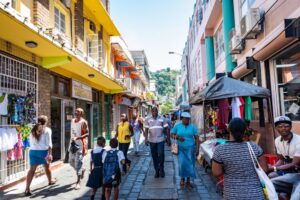
Air: Direct flights are offered from Miami and New York to E.T. Joshua Airport (SVD).
GETTING AROUND
The best way to get around St Vincent and the Grenadines is by taxi. Taxis are abundant and fares are reasonable. Renting a car is an option but not recommended as the roads can be tough to navigate. Ferries run daily between the islands.
GOOD TO KNOW
Country: St Vincent and the Grenadines
Time Zone: UTC-4
Primary Language: English
Currency: East Caribbean Dollar (XCD)
Cell Phone Service: Roaming fees apply.
Voltage: 220/240V
Passport and Visa: A valid passport is required.
Hurricane Details: June-November but islands are located on the edge of the hurricane area.
DIVE CONDITIONS
Water Temperature: Consistently in the 70s and 80s
Water Visibility: 60-80 feet and up to 100 feet on the outer reefs.
When to Go: December-April
Diving Difficulty: Beginner – Advanced
TOP DIVE SITES IN ST. VINCENT AND THE GRENADINES
St. Vincent and the Grenadines caters to the diving enthusiast! Listed are some of the very best that these islands can offer divers:
The Bat Cave is one of the more challenging, thrilling, and sought out dives in the Caribbean. Diver’s swim through a shallow, 300 -foot rocky passageway that cuts through the reef that dates back 250 years. The reef leads into a cave that is inside the cliff. A colony of bats are isolated above the cave and come out between the fissures to the reef and fly around divers. Birdwing parrotfish, blue tang, hawksbill turtles, hump head wrasse and barracuda can be found among the coral garden.
Anchor Reef was voted one of the top 100 dive sites in the world due to its incredible wall dive with swim throughs, coral reef formations and 18th-century anchor. Below the water, divers will spot pistol shrimp, eels, squid, and seahorses among the gorgonians. At 35 feet and at the edge of the wall is a hidden dark coral garden enhanced by the presence of sponges and coral. Sightings of long lure frogfish in assorted colors, long snout seahorses, black bar soldierfish, slipper lobsters, and octopus congregate here.
Mustique is a small island perfect for beginner and intermediate divers. The reef slopes and the coral are expansive. When diving this site, whale songs can often be heard and spotted drums and banded coral shrimp are sighted. A couple of highlight dives at this site are Shark Cave and The Pillories. At 90 feet and best for advanced divers, Shark Cave has flora and fauna where black-tipped sharks can be seen. Also common at this site are large sport fish like the Sad and the Cavali. The Pillories is a site best suited for beginner and intermediate divers. The flora and fauna at 14 feet are home to large populations of reef fish, lobsters, turtles, and eels.
Mayreau Gardens is home to the Puruni wreck of 1918. This British gunship lies in 40 feet of water. The expansive coral reef formation is perfect for drift dives. Crinoids, flamingo tongues, and garden eels can be commonly found here. This diving site is in the heart of the Grenadines and is not a common diving site, making it an unspoiled paradise known for beautiful reefs and world-class water.
Tobago Cays is called the crown jewel of the Grenadines and home to the green turtle. This site is a protected marine park that provides visitors with sugar sand and shallow turquoise water. Horseshoe reef surrounds this site and provides a perfect location for tropical nurseries for juvenile fish. This beautiful site served as the filming location for the Pirates of the Caribbean movie.
New Guinea Reef offers divers 100 feet of black coral. This reef differs from others in the area due to the intense and varied contrasting colors like bright pink and deep scarlet sponges. The cliffside walls have under hangs that are encrusted with sponges. The wall drops swiftly from 30 feet to 150 feet to a sea floor thick with branching vase sponges.
Coral Castle is one of the island’s most accessible dives and well suited for all levels of divers. The visibility at this site is 125 feet at its deepest point. Divers can explore this dramatic underwater structure filled with a variety of small tropical fish.
The Steps are located below the cliffs of Fort Charlotte near some steps leading into the sea. This spectacular dive site offers diverse marine life including red-lipped batfish, yellow-headed jaw fish and flamingo tongues.
Bequia is located 9 miles south of St Vincent and home to Hawksbill turtles. Most dives at this location are drift dives with incredible tunnels and holes, walls and over hangs. 30 dives sites that are easily accessible can be found around Bequia. There is an array of gently sloping reefs where rays, seahorses, pipefish, and eagle rays can be found.
Orca Point is a favorite night diving location with scattered boulders with overgrown encrusting sponges. Macro and sunspot anemone shrimp, neck crabs, blackened blennies, decorated crabs, three-spotted scorpionfish, and sharp-tail eels can be spotted here.
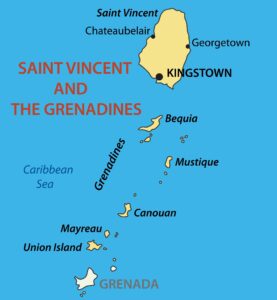
TOP ATTRACTIONS IN ST. VINCENT AND THE GRENADINES
Soufriere Volcano Hike is an adventurous demanding 4–6-hour hike that leads visitors to the 4000-foot summit of La Soufriere Volcano. This hike has ultimate views of St Vincent and the Grenadines.
Botanic Garden dates to 1765 and holds the reputation as the oldest botanical garden. The 20-acre park includes collections of tropical flora and fauna and trees including mahogany and breadfruit.
Mustique is the highly coveted playground of the rich and famous since the late Princess Margaret decided to live here. Visitors can hope to spot and interact with residents of the island including Tommy Hilfiger, Mick Jagger, and Paul Newman. Ferry services to the island are only available once a day and only a few times a week.
Kingstown is located on the island’s southern coast and is the capital city. Cobblestone streets and a bustling harbor attract travelers to enjoy the vivacious market and interesting scenery. Spectacular views can be seen at Fort Charlotte, a colonial era fort that can be reached via taxi.
Dark View Falls holds St Vincent’s most accessible and beautiful waterfalls. The 15-minute hike includes crossing the Richmond River on a bridge made of bamboo poles. A walk through the bamboo grove leads visitors to the first waterfall and a short uphill walk to the second waterfall. Both falls descend into beautiful pools of water where visitors can enjoy a swim.
Bequia is just 7 square miles but offers a glimpse of the Caribbean before upscale resorts moved in. Visitors can wander the one and only road in town the follows the waterfront in the capital of Port Elizabeth. Conch shells are blown as horns as fishers arrive with fresh fish. Located an hour from St Vincent this visit is a step back in time.
Owia Salt Pond was formed by the lapping waves over rock formations which created a natural reef. Protected by the volcanic rock, this beautiful, and peaceful pool attracts brightly colored reef fish.
Known for its critter or macro diving and warm sands said to have medicinal properties, St Vincent and the Grenadines are a paradise that is unmatched. Swimming with squadrons of eagle rays and manta, patrolling reef sharks and barracudas add to the excitement of the dives found in these islands. The real beauty for divers is the variety of unique marine life on show such as frogfish, seahorses, anemones, tunicates, nurse sharks, lobsters, octopus, squid, colorful mollusks, and crustaceans. St Vincent and the Grenadines is diving wonderland just waiting to be explored.

